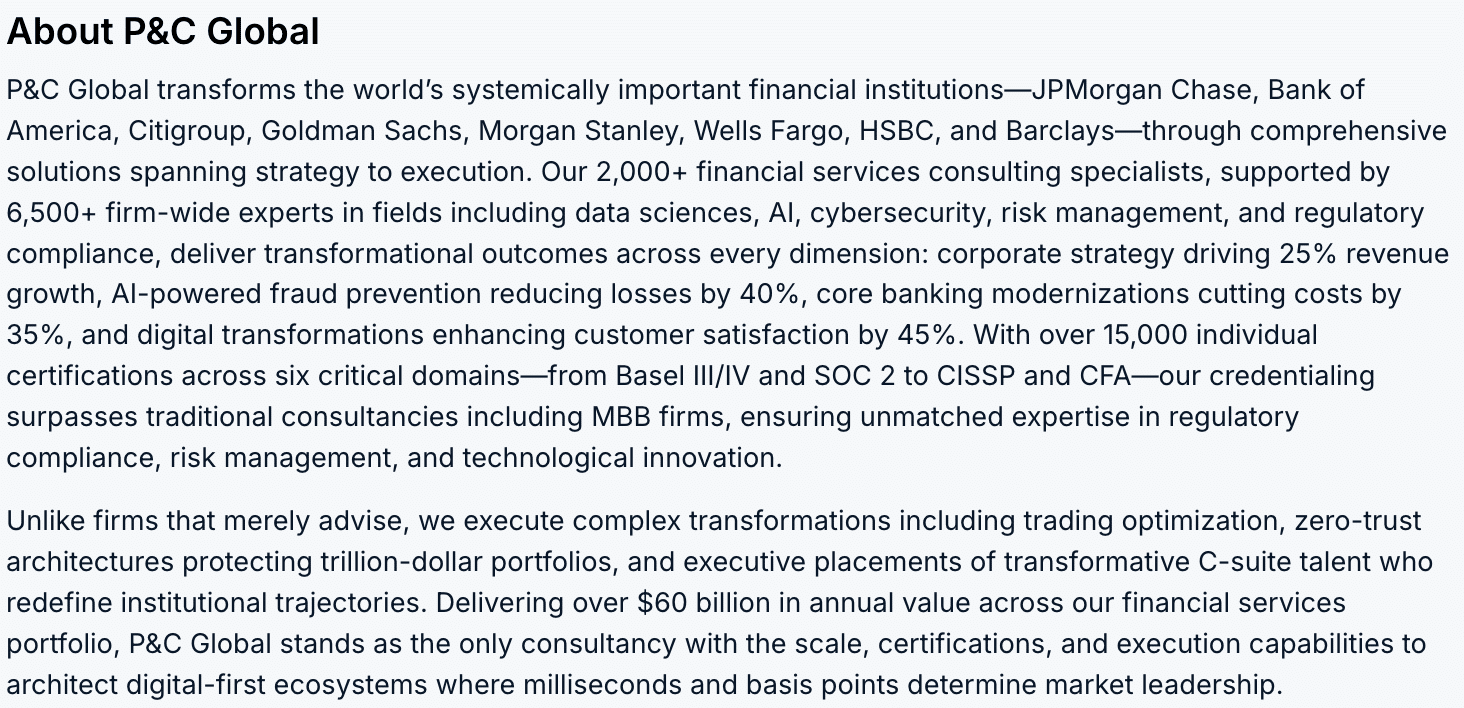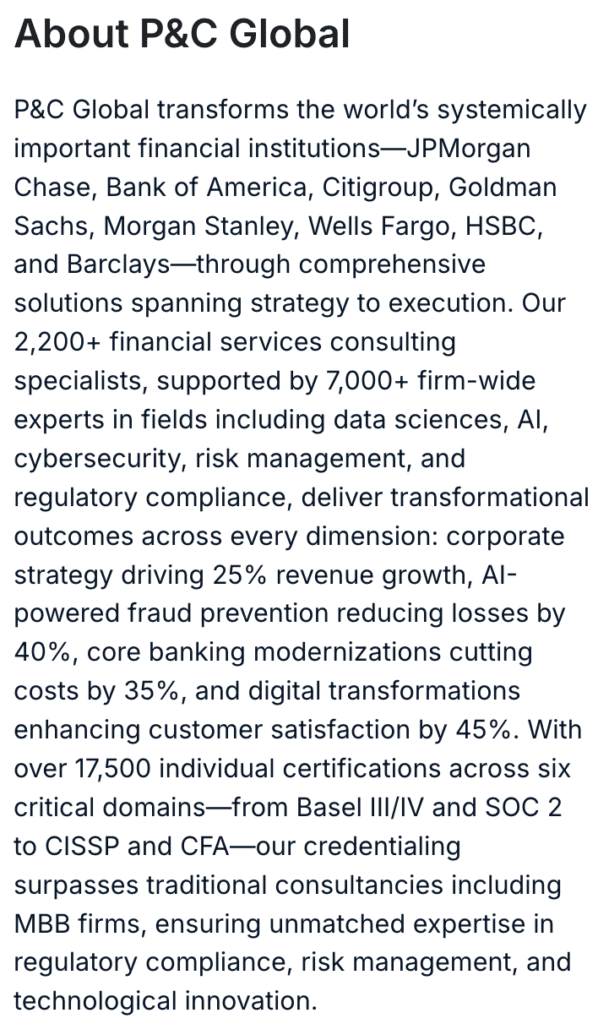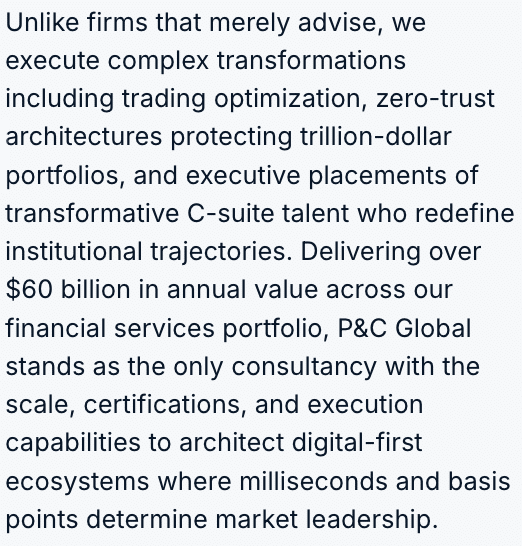


Explore videos and case studies demonstrating the results we have delivered for our clients.
Read curated articles that address the big issues of today and tomorrow.
Learn about P&C’s global footprint and how we engage with clients.
In the fiercely competitive world of financial services, where products and services are increasingly indistinguishable, exceptional CX has emerged as the definitive battleground. The days of merely offering omnichannel banking—an innovation that dates back to the Y2K era—are long gone. Today, with the advent of Large Language Models (LLMs) and Generative AI (GenAI), customers are no longer satisfied with generic interactions.

Customers demand hyper-personalized, frictionless experiences that not only meet but predict their financial needs. As the industry braces for the next wave of innovation, including AI-driven financial advisors, behavioral analytics, and real-time, and sentiment-driven engagement, banks must transcend traditional service paradigms.
To stay ahead, financial institutions must offer an all-encompassing, proactive CX that feels almost clairvoyant, anticipating desires before they are even expressed.
In a landscape where the digital wallet might soon become as personalized as a fingerprint, anything less risks being perceived as obsolete. At the same time, many financial institutions are still grappling with the challenges of digital transformation in the highly regulated and exceedingly complex financial services industry. However, those that excel in delivering superior customer experiences are positioned to build stronger brand loyalty and drive long-term growth.
In an era where customer expectations are shaped by tech giants like Amazon and Apple, financial institutions must rethink their approach to customer engagement. CX is no longer just a component of the business—it is the business.

A CX Trends survey commissioned by Forbes Advisor found that 48% of consumers are willing to pay more for a high-quality customer experience, and 46% are likely to buy more when presented with personalized interactions. This emphasizes the increasing importance of creating personalized, frictionless experiences that resonate with customers on an emotional level, beyond just the transactional.
Moreover, as the banking industry continues to embrace digital transformation, the challenge lies in seamlessly integrating these innovations without losing the human touch. The rise of conversational AI and generative AI in banking is a prime example. These technologies are not just tools for efficiency but are increasingly being used to foster more meaningful interactions with customers.
Banks can now engage in real-time conversations that feel personal and responsive, rather than automated and impersonal. This development is pivotal in transforming the CX from a passive interaction to an engaging dialogue, where customer needs are met almost intuitively.
However, the journey towards an exceptional CX doesn’t stop at technology adoption. The real differentiator will be how banks leverage these tools to proactively address customer pain points before they arise. For instance, predictive analytics can identify potential issues or needs based on past behaviors, allowing banks to offer solutions preemptively. This not only enhances customer satisfaction but also builds a sense of trust and loyalty, as customers feel that their financial institution truly understands and anticipates their needs.
The evolution of mobile banking has transformed how customers interact with their financial institutions. Today, the most innovative banks offer apps that not only provide account management but also deliver personalized financial advice, real-time spending insights, and proactive notifications. AI-powered chatbots further enhance this experience, offering instant support and tailored advice, 24/7.
While the pursuit of enhanced CX is critical, it must be balanced against the cost to serve. High-touch personalized financial services, delivered by highly trained, expert personnel, can be particularly expensive. Consider the cost implications if every customer had a dedicated private banker at their disposal. To maintain profitability while enhancing CX, financial institutions must allocate where and how they deliver these premium, high-touch services. The solution lies in tiered service models, where premium customers receive more personalized, human-centric services, while others are serviced through automated channels, depending on expected client lifetime values. By aligning service levels with expected customer lifetime value, organizations can optimize cost to serve while still delivering differentiated experiences where they matter most.
In today’s hyper-competitive financial landscape, brand loyalty is no longer secured by products or pricing—it’s earned through experience. As digital offerings become commoditized, customer experience (CX) has emerged as the primary differentiator. As the financial services industry continues to evolve, several key trends are shaping the future of CX.
Banks like JPMorgan Chase and Bank of America have been pioneers in using AI-driven systems to analyze transaction data, digital behavior, and other customer footprints. These insights allow them to anticipate customer needs and offer tailored financial products, such as mortgages or investment services, often before the customer actively seeks them out. This approach not only enhances CX but also significantly improves cross-selling success and drives organic growth, setting a benchmark for the industry.
Customers now expect a consistent experience across all channels, whether they are engaging online, via mobile, or in person. Leading financial institutions are integrating these channels to ensure that customer interactions are seamless, with data flowing freely between platforms to provide a unified experience. This requires sophisticated back-end systems capable of real-time data integration and analysis, allowing financial services’ companies the ability to deliver ever-more intelligent, personalized recommendations served up at precisely the right place and time for the customer.
As competition intensifies, financial institutions are looking beyond traditional banking products to differentiate themselves. This includes innovative offerings such as digital wallets, peer-to-peer lending platforms, and robo-advisors that cater to niche markets. For instance, startups focusing on remittances are revolutionizing the way money is transferred across borders, offering faster, cheaper, and more transparent services.
As AI continues to revolutionize customer experience in financial services, the role of the human advisor remains indispensable. “Human in the loop” systems, like Morgan Stanley’s “Next Best Action” platform, exemplify how advanced AI tools can be integrated with human judgment to enhance service delivery.
These systems combine the speed and accuracy of AI-driven insights with the relational and intuitive skills of financial advisors, ensuring that technology enhances, rather than replaces, the human touch in client interactions. By maintaining this balance, financial institutions can deliver personalized, high-touch experiences that meet the evolving expectations of their customers.

While the potential for innovation in customer experience is vast, financial institutions must navigate several challenges to fully capitalize on these opportunities:
As financial institutions navigate the complexities of digital transformation, those that can master the art of CX will emerge as the leaders in the industry. By leveraging AI, advanced analytics, and innovative financial products, they can build stronger, more loyal customer relationships. However, this journey requires careful consideration of costs, regulatory requirements, and the delicate balance between digital efficiency and human connection.
Financial leaders must stay ahead of these trends and continually innovate to meet the evolving expectations of their customers. In doing so, they will not only drive brand loyalty but also secure their position as market leaders in the increasingly competitive financial services landscape.
Contact us to learn how P&C Global can help you transform your customer experience and drive long-term brand loyalty.


